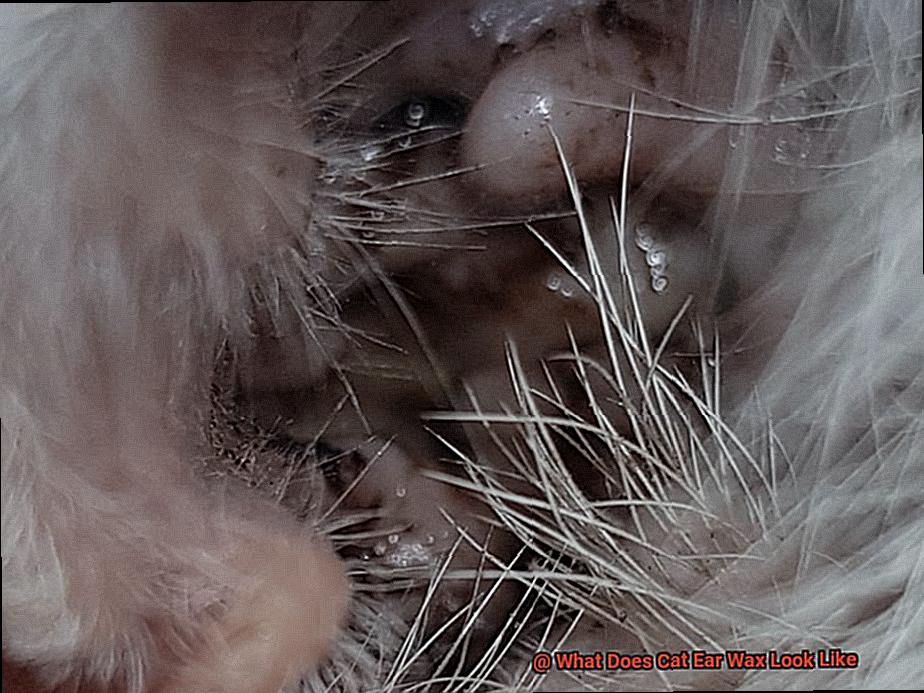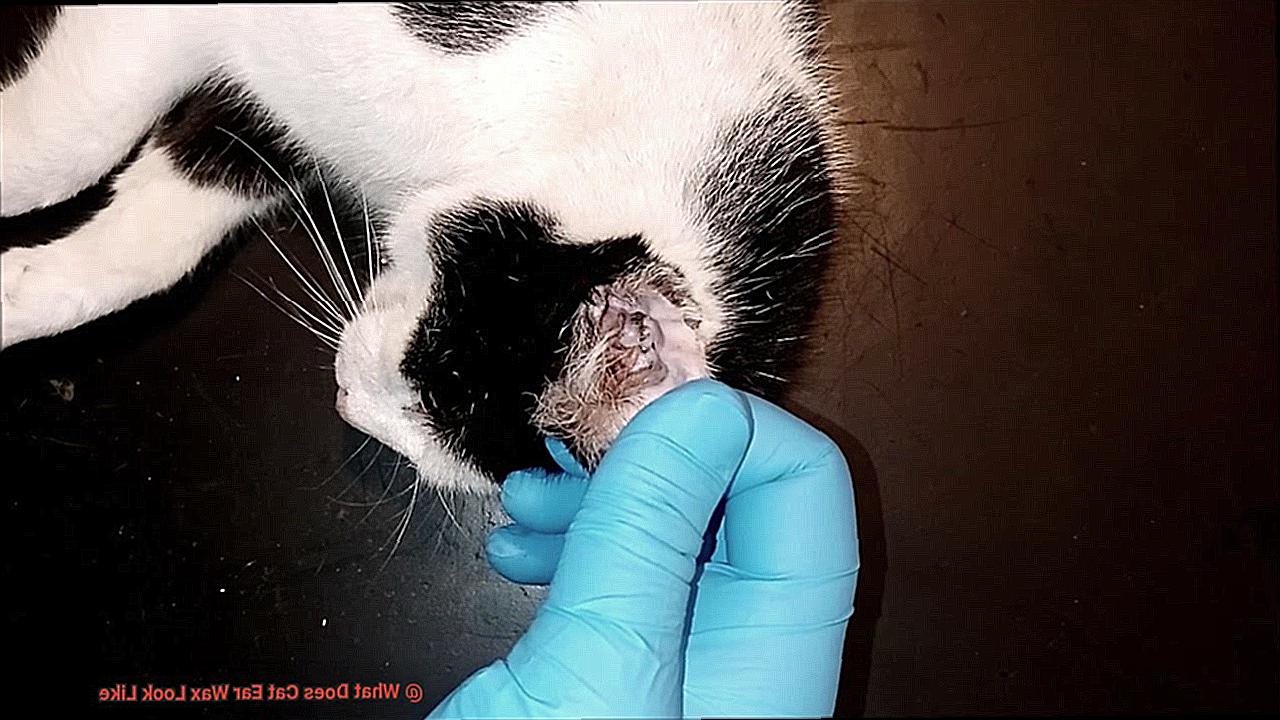It’s natural to be curious about your feline friend’s health and well-being.
One aspect of cat care that often goes overlooked is ear wax. While it may not be the most glamorous topic, understanding what cat ear wax looks like can go a long way in keeping your kitty healthy and free from potential ear infections.
So, what exactly does cat ear wax look like? The answer varies based on factors such as breed, age, and overall health.
Typically, healthy ear wax will have a sticky consistency and appear light brown or caramel in color. However, if you notice that your cat’s ear wax is dark or black with a crumbly texture, this could be a sign of an underlying issue such as an ear infection or mites.
On the other hand, if your cat’s ear wax appears light yellow or white, they may be producing excessive amounts of wax or have an underlying medical condition that requires attention. If you’re concerned about your cat’s ear health or simply curious about their ear wax appearance, it’s always best to consult with your veterinarian.
By providing proper care and attention to your furry friend’s ears, you can help ensure their continued health and happiness.
What Does Cat Ear Wax Look Like?
One aspect of this is understanding what cat ear wax looks like.
While a small amount of ear wax is normal and healthy, excessive buildup can lead to potential health problems. Cat ear wax can vary in color and texture depending on the cat.
Generally, it is dark brown or black in color. It can be dry and flaky or moist and waxy, and may appear crusty or sticky on the outside of the ear canal.
If you notice any changes in color or consistency, such as yellow or green wax, it could be a sign of an underlying health issue such as infection. Thick and greasy wax may indicate a parasite infestation.
It’s important to keep an eye on your cat’s ears and clean them regularly to prevent excessive buildup. Some cats naturally produce more ear wax than others, but if you notice any changes in behavior related to their ears or unusual changes in their ear wax, consulting with a veterinarian is recommended.
Remember that cat ear wax serves as a protective barrier for their ears against dirt and debris, so a small amount is healthy.
Variations in Color and Texture of Cat Ear Wax
While most ear wax is typically brown, yellow, and waxy, there are some exceptions to watch out for.
Black ear wax is a red flag that your cat might have a bacterial or fungal infection. Think of it as an undercover agent’s earpiece being penetrated by the enemy – it’s time to call in the experts.
On the other hand, dark red or brown wax could indicate a ruptured blood vessel in the ear canal, similar to a wound that needs to be handled with care. Texture is also relevant.
Dry and flaky ear wax may indicate that your cat isn’t grooming properly or is dehydrated, like a soiled old book that hasn’t been touched in years. Wet and sticky wax, on the other hand, could be a result of an infection or excessive cerumen production.
It’s like trying to walk through a swamp – not a good idea for anyone concerned. To ensure that your cat stays healthy, make sure to check their ears regularly for any changes in color or texture of their ear wax.
If you notice anything abnormal, seek veterinary attention right away.
Normal Amounts of Ear Wax in Cats
It’s crucial to keep your cat’s ears clean and safe, just like James Bond keeps his earpiece organized and working.

Ear wax in cats is a natural defense mechanism against harmful agents that can cause infections. Normal ear wax should be light brown or yellowish with a slightly waxy texture, and should not have a foul odor or discharge.
However, some breeds of cats may produce more ear wax than others. For example, long-haired or floppy-eared cats are more prone to ear wax buildup.
Regularly checking and cleaning your cat’s ears can help prevent excessive buildup and potential health issues. If you notice any changes in the color or texture of your cat’s ear wax or an increase in the amount produced, it could be a sign of an underlying health condition.
Signs of Excessive Ear Wax Buildup in Cats
As much as cats love grooming themselves, excessive ear wax buildup can cause discomfort and infections.
That’s why it’s important to know the signs of excessive ear wax buildup in your furry friend. The first sign to look out for is visible ear wax.
If you notice a brown or yellowish substance in your cat’s ear canal, it’s time to take action. This may also be accompanied by a foul odor or discharge from the ear.
Another indication is frequent scratching or rubbing of the ears. If your cat seems to be constantly pawing at their ears or rubbing them against furniture or other objects, it could be a sign of discomfort caused by excessive ear wax buildup.

Changes in behavior can also be a red flag. Cats with excessive buildup may become more irritable or agitated, or they may show signs of lethargy and disinterest in normal activities.
Don’t let your cat suffer in silence. Regularly cleaning your cat’s ears can help prevent excessive wax buildup, but if the problem persists, it may be necessary to seek veterinary care to ensure that there are no underlying health issues causing the problem.

Home Care for Cat Ears
One of the ways to achieve this is by taking care of their ears.
Cats can suffer from ear infections and ear mites, which can cause discomfort and lead to more severe health issues. But don’t worry, with a little bit of knowledge and dedication, you can easily take care of your cat’s ears right at home.
The first step in home care for cat ears is recognizing the signs of ear mites and infections. Ear mites are tiny parasites that can cause a dark, crusty buildup in your cat’s ears, accompanied by excessive scratching and head shaking.
On the other hand, ear infections can cause an overproduction of wax, leading to a thick, yellow or brown buildup in the ears, redness, swelling, and a foul odor. If you notice any of these symptoms, it’s crucial to seek veterinary attention right away.
To prevent these problems from occurring in the first place, it’s important to clean your cat’s ears regularly. However, you must use caution when cleaning as using cotton swabs or other tools can damage their delicate ear structures and push dirt and debris further into the ear canal.
Instead, opt for a gentle cleaning solution recommended by your veterinarian. These solutions are typically applied to a cotton ball or pad and used to clean around the outer part of the ear.
It’s also essential to know what healthy ear wax looks like in cats – usually light brown with a waxy texture. If you notice any changes in color or texture, it’s best to consult your veterinarian before attempting to clean your cat’s ears at home.
By keeping your cat’s ears clean and free of excess wax buildup, you’re helping promote their overall health and wellbeing.
When to Visit a Vet
While it’s easy to overlook your cat’s ears when it comes to their well-being, excessive or unusual ear wax can be a sign of an underlying health problem.

So, when is it time to head to the vet for your cat’s ear wax? Firstly, if you notice that your cat’s ear wax is dark brown or black and has a foul odor, it could be a sign of an ear infection.
Keep an eye out for symptoms like head shaking, ear scratching, and redness or swelling in the ear. If you do spot any of these signs, it’s essential to get your cat to the vet as soon as possible.
Secondly, if your cat has a lot of ear wax buildup that is affecting their hearing or causing discomfort, it may also be time to visit the veterinarian. This could be an indication of an ear mite infestation or another underlying health issue that needs addressing.
Your vet can safely and effectively clean your cat’s ears and treat any underlying conditions that may have caused the buildup. In general, it’s recommended that your cat’s ears are checked by a vet once a year to ensure their overall health and well-being.
However, if you notice changes in your cat’s ear wax or behavior related to their ears, don’t hesitate to seek veterinary attention right away. Remember, taking care of your cat’s ears is crucial for their overall health and happiness.
You can help keep your feline friend healthy and happy for years to come by recognizing the signs of ear problems and seeking veterinary care when necessary.
BZTPZ71K-Bo” >
Conclusion
In conclusion, understanding what cat ear wax looks like is an essential aspect of responsible pet ownership.
Healthy ear wax in cats should have a sticky consistency and appear light brown or caramel in color. However, any changes in color or texture could indicate an underlying issue such as mites or an ear infection.
Neglecting your cat’s ears can lead to future health problems, so it’s crucial to keep a close eye on them and clean them regularly. By routinely checking and cleaning your feline friend’s ears, you can prevent excessive buildup and potential health complications.
Remember that healthy ear wax in cats should be light brown with a waxy consistency. If you notice any changes in their ear wax, seek advice from your veterinarian before attempting to clean their ears at home.
If you observe any signs of excessive ear wax buildup or behavioral changes related to their ears, don’t hesitate to consult a vet right away.
Your cat’s overall well-being and happiness depend on proper care and attention to their ears, just like James Bond relies on his functioning earpiece for success.







